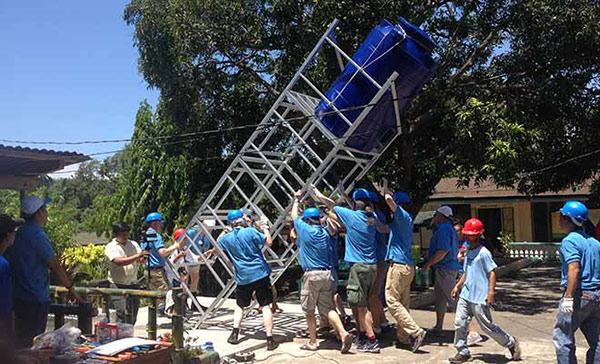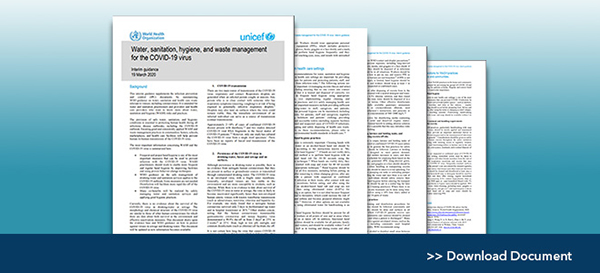Solving Water During a Pandemic: What Could Be More Essential?
(Updated November 2021)
Like a lot of you, I am following in earnest developments related to the global coronavirus pandemic. My heart aches for the loss of life that COVID-19 has caused, and I would be lying if I said I wasn’t worried at all about my family, particularly our elders. I am watching with awe and the utmost respect as first responders put themselves in harm’s way while saving lives, and at the same time I am eagerly anticipating that my colleagues on the “clinical” side of microbiology will arrive at a safe and effective vaccine that will stem the coronavirus tide in months to come (albeit several months).
As someone fortunate enough to work for a company whose motto is “Let’s Solve Water,” I am also deeply grateful for my colleagues and customers in the water industry who are keeping our taps and sewers running, while protecting water quality in our homes and in the environment. Xylem is qualified as an “essential” business, serving the municipalities, agencies, and scientists that maintain this infrastructure, and our CEO Patrick Decker has shown exceptional leadership during this time. At ysi.com/coronavirus-actions you can learn more about how Xylem has activated business continuity plans and our Pandemic Risk Mitigation Plan so that we can continue to support these critical functions globally.
Xylem’s response prompted both the humanitarian and the microbiologist in me to reflect upon the intersection of coronavirus and water. I taught a virology course many years ago and wanted to refresh my knowledge with this new perspective—the information I’ve found is quite encouraging! I’ll share some of it here, starting with a bit of boiled-down biology about viruses. The biology fundamentals will make it apparent that continuing standard water treatment practices is paramount for ensuring the safety of our water supplies and waterways, and for protecting the individuals who work in water plants of all types. It will also be clear why Xylem must continue to strive for access to clean water globally, a hallmark of our Watermark program.

A Very Brief Primer on Viruses
From the days of my first college biology courses 30 years ago (!) until today it is still not agreed whether, in biological terms, a virus is “alive.” While it’s an interesting philosophical question, scientifically I’m not sure that it matters. My view on this was formed when infectious agents like prions emerged in the 1990s, which are even more stripped of the standard componentry we associate with living cells. In the end viruses and prions command our respect, irrespective of whether they are “living” or “nonliving.”
Any virus may be built from two or more of the four principle macromolecules which we associate with life: proteins, nucleic acids, lipids, and carbohydrates. Some viruses are little more than a raging packet of protein and nucleic acid (e.g. Narnaviridae). Others are so large and complex (like Cytomegalovirus of the family Herpesviridae) that if they had some organelles or more fundamental cellular machinery we might clearly consider them “living.”
In the case of coronavirus, it consists of a single strand of ribonucleic acid (positive-sense RNA, for you biologists out there), a lipid-based envelope, and a protein capsid with specialized glycoprotein “spikes”. Glycoproteins are proteins containing some carbohydrate bits that help the virus attach to human respiratory tract cells, and in the case of coronavirus they may form the basis of a vaccine.

But macromolecules alone do not make a cell, and activities like autonomous replication and repair, and responses to the external environment are something that cells do that viruses for the most part do not. The only way viruses can replicate, build more of themselves, and truly respond is within the context of a host. They are obligated to a parasitic lifestyle.
The consequence of a parasitic lifestyle is that when left to their own devices in the environment, viruses will eventually fall apart. The macromolecules of life can be relatively fragile when they are not working together in the context of a cell. While there has been a lot of discussion in the news about contracting coronavirus from doorknobs and other surfaces, which is a possibility I do not dismiss, in reality viruses don’t last long out there. How long depends on the virus and the environment. The effects of sunlight, dehydration, and temperature will eventually denature a virus in a time and dose-dependent manner.
But we know from human history that a number of waterborne illnesses have been caused by viruses: polio, hepatitis, and gastrointestinal viruses can be transmitted through water contaminated with human or animal waste, for example. Survival of a virus in water depends on many of the standard water quality parameters I’ve often discussed: temperature, pH, salinity, and organic matter to name a few. Further, these illnesses all involved contaminated waters, and viruses of different families. So what’s the real risk for the coronavirus that causes COVID-19?
Can Coronavirus Be Contracted Through Water?
The World Health Organization provides great insight in its document entitled “Water, sanitation, hygiene, and waste management for the COVID-19 virus.” Importantly they point out,
Although persistence in drinking-water is possible, there is no evidence from surrogate human coronaviruses that they are present in surface or groundwater sources or transmitted through contaminated drinking water.

Some may remember the SARS coronavirus outbreak in 2003, and a lot of the work done with that strain informed this statement from the WHO. The SARS coronavirus is one of the “surrogate human coronaviruses” they refer to. Returning to our basic biology, coronaviruses have a lipid envelope and it ends up that the envelope is pretty fragile in the environment, and also makes the virus more susceptible to oxidants like chlorine. In other words...
The same practices we use every day to disinfect drinking water are highly effective against coronaviruses. This is great news if you are in a part of the world with access to treated drinking water and sanitary sewers. If these are not available, boiling water can kill coronavirus, and home-based treatment technologies, namely ultrafiltration or nanomembrane filters, solar irradiation and UV irradiation (if the water is non turbid) can all be used. Some people also do their own dosing with chlorine or bromine, both of which are effective when properly used.
What about wastewater? There is good news there, too. The same practices that operators working in wastewater plants employ every day to protect themselves from other viruses and things like E. coli should protect them from coronaviruses that may be in sewage or other waste streams. Note that the virus can be detected in the feces of patients, and so it can enter into wastewaters that must be treated.
And while we're on the topic of wastewater, keeping those systems functioning properly both in your home and in the plant is more important than ever. If you're using disinfecting wipes, for instance - please don't flush them! They wreak havoc on most plumbing and sewage systems because they don't degrade the way standard toilet paper does. The CDC, the American Water Works Association, and The Water Environment Federation are all excellent resources on the topic of wastewater and I encourage my colleagues in the industry to review the information found at these links.
So while survivability of the strain of coronavirus causing COVID-19 in natural waters is not specifically known, we do know that these treatments are effective for the rest of the coronaviruses based on what we learned from SARS and other strains. As long as we maintain current practices, the likelihood of contracting COVID-19 via your drinking water or in a water treatment facility should be negligible.
In case you haven’t hear enough about it, I want to cover one more topic related to water, and that is handwashing.
Use Soap People
You may think you’ve heard it all about handwashing by now, but have you wondered why, if the water coming out of your tap is virus-free and in many parts of the world, chlorinated, everyone keeps saying to use soap and water, and not just water?

Like most things, it’s all about chemistry (and hence, biology). Soap is a surfactant that makes nonsoluble particles soluble in water. Guess what’s nonsoluble in water… that's right, coronavirus.
That lipid membrane on the outside of the coronavirus acts like oil in water—it doesn’t dissolve. It also sticks pretty well to your hands, which is why you should avoid touching your face. (And by the way, I’ve learned in the past two weeks that I freaking love touching my face). Just like when you get grease on your hands from cooking, the virus doesn’t come off with just water. You have to use soap.
And no, it doesn’t need to be antibacterial soap. In the same way that antibiotics can’t be used to treat COVID-19, antibacterial soap is not “better” than plain soap. The antibacterial properties have some efficacy against bacteria like E. coli, but don’t have any effect at all on viruses.
So I’ll leave you with my favorite resource on handwashing, the CDC’s “Show me the Science – How to Wash Your Hands” page, and many hopes for the health and safety of you and your family. This blog is brief (by my standards), and if readers would like me to expound more deeply on any of the topics covered here please let me know. Finally, if you have questions about your work with Xylem please contact your local Xylem support team. You can email us at info@ysi.com. Alternatively, you can email us at COVID-19@xyleminc.com.